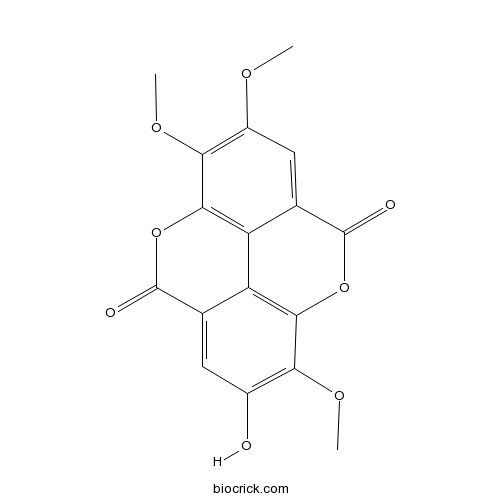2,3,8-Tri-O-methylellagic acidCAS# 1617-49-8 |

Quality Control & MSDS
3D structure
Package In Stock
Number of papers citing our products

| Cas No. | 1617-49-8 | SDF | Download SDF |
| PubChem ID | 5281860 | Appearance | Powder |
| Formula | C17H12O8 | M.Wt | 344.3 |
| Type of Compound | Phenols | Storage | Desiccate at -20°C |
| Solubility | Soluble in Chloroform,Dichloromethane,Ethyl Acetate,DMSO,Acetone,etc. | ||
| SMILES | COC1=C(C2=C3C(=C1)C(=O)OC4=C3C(=CC(=C4OC)O)C(=O)O2)OC | ||
| Standard InChIKey | LXEQIOGTMDLLEC-UHFFFAOYSA-N | ||
| General tips | For obtaining a higher solubility , please warm the tube at 37 ℃ and shake it in the ultrasonic bath for a while.Stock solution can be stored below -20℃ for several months. We recommend that you prepare and use the solution on the same day. However, if the test schedule requires, the stock solutions can be prepared in advance, and the stock solution must be sealed and stored below -20℃. In general, the stock solution can be kept for several months. Before use, we recommend that you leave the vial at room temperature for at least an hour before opening it. |
||
| About Packaging | 1. The packaging of the product may be reversed during transportation, cause the high purity compounds to adhere to the neck or cap of the vial.Take the vail out of its packaging and shake gently until the compounds fall to the bottom of the vial. 2. For liquid products, please centrifuge at 500xg to gather the liquid to the bottom of the vial. 3. Try to avoid loss or contamination during the experiment. |
||
| Shipping Condition | Packaging according to customer requirements(5mg, 10mg, 20mg and more). Ship via FedEx, DHL, UPS, EMS or other couriers with RT, or blue ice upon request. | ||
| Description | 1. 2,3,8-tri-O-Methyl ellagic acid has antimicrobial activity agaist Vibro cholera, Staphylococcus aureus, Klebsiella pneumoniae, Pseudomonas aeruginosa, Bacillus cereus, Escherichia coli . |
| Targets | Antifection |

2,3,8-Tri-O-methylellagic acid Dilution Calculator

2,3,8-Tri-O-methylellagic acid Molarity Calculator
| 1 mg | 5 mg | 10 mg | 20 mg | 25 mg | |
| 1 mM | 2.9044 mL | 14.5222 mL | 29.0444 mL | 58.0889 mL | 72.6111 mL |
| 5 mM | 0.5809 mL | 2.9044 mL | 5.8089 mL | 11.6178 mL | 14.5222 mL |
| 10 mM | 0.2904 mL | 1.4522 mL | 2.9044 mL | 5.8089 mL | 7.2611 mL |
| 50 mM | 0.0581 mL | 0.2904 mL | 0.5809 mL | 1.1618 mL | 1.4522 mL |
| 100 mM | 0.029 mL | 0.1452 mL | 0.2904 mL | 0.5809 mL | 0.7261 mL |
| * Note: If you are in the process of experiment, it's necessary to make the dilution ratios of the samples. The dilution data above is only for reference. Normally, it's can get a better solubility within lower of Concentrations. | |||||

Calcutta University

University of Minnesota

University of Maryland School of Medicine

University of Illinois at Chicago

The Ohio State University

University of Zurich

Harvard University

Colorado State University

Auburn University

Yale University

Worcester Polytechnic Institute

Washington State University

Stanford University

University of Leipzig

Universidade da Beira Interior

The Institute of Cancer Research

Heidelberg University

University of Amsterdam

University of Auckland

TsingHua University

The University of Michigan

Miami University

DRURY University

Jilin University

Fudan University

Wuhan University

Sun Yat-sen University

Universite de Paris

Deemed University

Auckland University

The University of Tokyo

Korea University
- Caesalpine B
Catalog No.:BCN7377
CAS No.:1616757-60-8
- Caesalpine A
Catalog No.:BCN7376
CAS No.:1616757-59-5
- Dodovislactone B
Catalog No.:BCN7398
CAS No.:1616683-55-6
- Dodovislactone A
Catalog No.:BCN7399
CAS No.:1616683-54-5
- Dodovisone D
Catalog No.:BCN6871
CAS No.:1616683-53-4
- Dodovisone C
Catalog No.:BCN6872
CAS No.:1616683-52-3
- Dodovisone B
Catalog No.:BCN6867
CAS No.:1616683-51-2
- Dodovisone A
Catalog No.:BCN6839
CAS No.:1616683-50-1
- ONC201
Catalog No.:BCC3989
CAS No.:1616632-77-9
- Erythrinin H
Catalog No.:BCN6870
CAS No.:1616592-62-1
- Erythrinin G
Catalog No.:BCN6857
CAS No.:1616592-61-0
- 1,5-difluoro-3-methyl-2-nitrobenzene
Catalog No.:BCN6404
CAS No.:1616526-80-7
- Amentoflavone
Catalog No.:BCN6283
CAS No.:1617-53-4
- Lupeol acetate
Catalog No.:BCN6893
CAS No.:1617-68-1
- Lupenone
Catalog No.:BCN1717
CAS No.:1617-70-5
- Vincamine
Catalog No.:BCN2606
CAS No.:1617-90-9
- Z-Ile-Leu-aldehyde
Catalog No.:BCC5591
CAS No.:161710-10-7
- Tebipenem
Catalog No.:BCC5550
CAS No.:161715-21-5
- Tebipenempivoxil
Catalog No.:BCC3861
CAS No.:161715-24-8
- Rasagiline mesylate
Catalog No.:BCN2166
CAS No.:161735-79-1
- GLP-1 (9-36) amide
Catalog No.:BCC6001
CAS No.:161748-29-4
- 12-Oxocalanolide A
Catalog No.:BCN4699
CAS No.:161753-49-7
- Palmatrubine
Catalog No.:BCN2647
CAS No.:16176-68-4
- Esomeprazole Sodium
Catalog No.:BCC4376
CAS No.:161796-78-7
Diterpenoids from Neoboutonia glabrescens (Euphorbiaceae).[Pubmed:12943778]
Phytochemistry. 2003 Sep;64(2):575-81.
Glabrescin, a daphnane diterpenoid, neoboutonin, a degraded diterpenoid with a novel skeleton, and neoglabrescins A and B, two rhamnofolane derivatives, have been isolated from the stem bark of Neoboutonia glabrescens Prain (Euphorbiaceae), together with the known tigliane derivative, baliospermin, and the known daphnane, montanin. Other constituents include squalene, 3-acetylaleuritolic acid, oleanolic acid and sitosterol, and the phenolic compounds 9-methoxy-1,7-dimethylphenanthrene and 2,3,8-Tri-O-methylellagic acid. The structures were assigned on the basis of spectral studies and comparison with published literature data. The structures of neoglabrescins A and B were derived for their acetylated derivatives and, in the case of neoglabrescin A, confirmed by X-ray crystallographic analysis.


